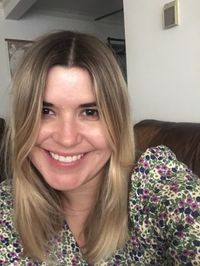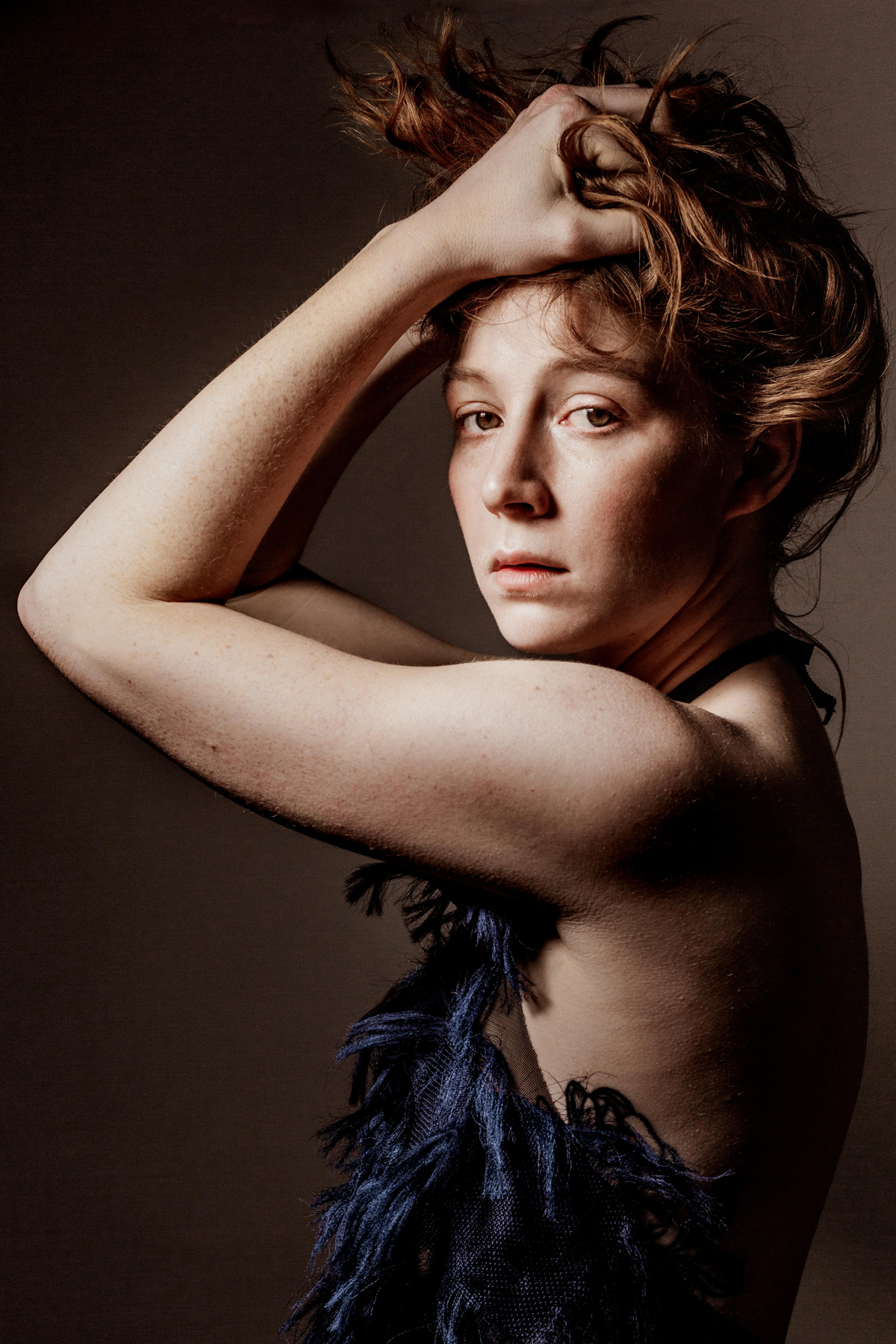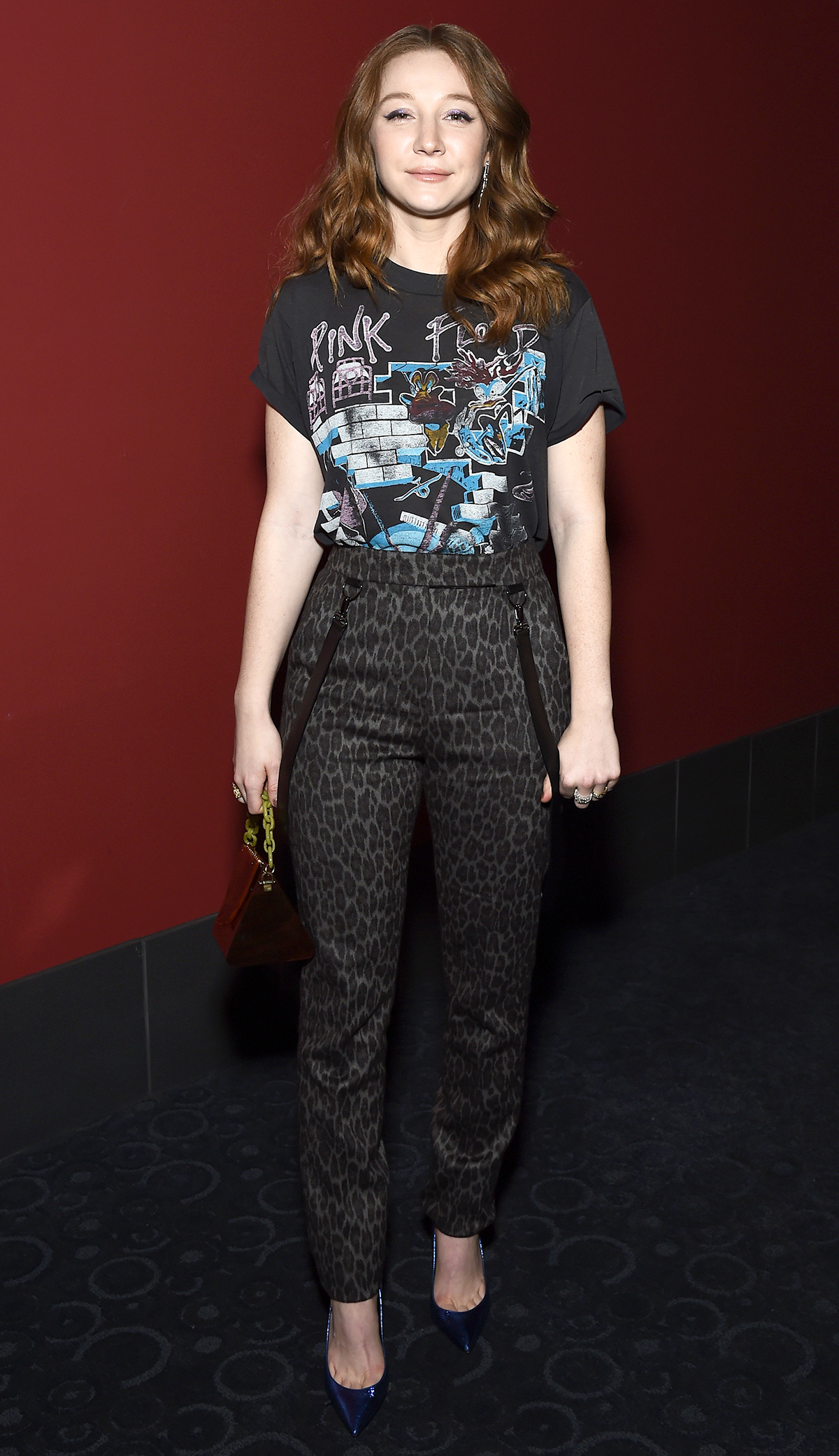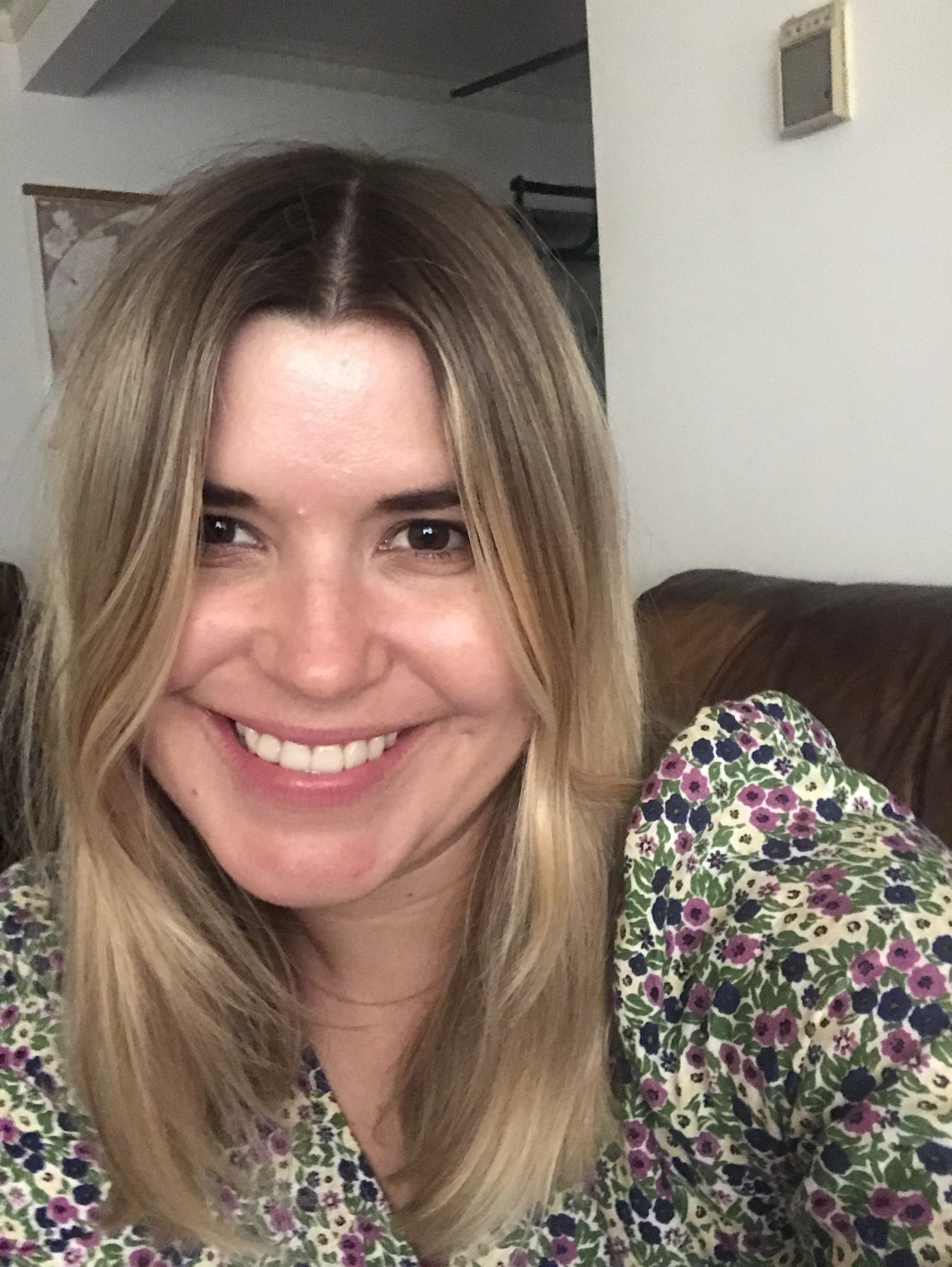Mrs. America Actress Kayli Carter on the Best and Worst '70s Fashion Moments

Kayli Carter has a lot to be excited about—the actress has three major projects (Mrs. America, Bad Education, and Let Him Go) hitting screens in the span of a few months—but it’s hard not to feel the weight of the moment as we connect via phone on opposite coasts during what is week four of quarantine. Under normal circumstances, Carter would be gearing up for the big premiere of her new limited series Mrs. America, a brilliantly acted drama about the 1970s battle over the Equal Rights Amendment, but instead, she is spending her days in loungewear by The Great, honing her baking skills. ("In my other dream life, I would work in the [Bon Appétit] test kitchen.”) But for a young actress in the midst of a banner year, Carter is taking it all in stride.
While this might be your first introduction to Carter, it wouldn’t be fair to call her a newcomer. In fact, the 27-year-old began her acting career full throttle a little over six years ago and hasn’t slowed since. Her first professional theater role in 2016 was a monumental one in Mark Rylance’s play Nice Fish at the prestigious West End theater in London. And after a few years on stage, she seamlessly crossed over to film and television with critically acclaimed roles in the Netflix series Godless and indie film Private Life, the latter of which earned her an Independent Spirit Award nom for Best Supporting Female. And now she’s rubbing shoulders with the likes of Cate Blanchett, Allison Janney, and Diane Lane, to name just a few. If anything is certain at this time, it’s that Carter is one to keep an eye on in 2020 and beyond.
While it can be difficult to find moments of respite and joy during this global public health crisis, in the 30 minutes I spent speaking with Carter about everything from the good and bad of ’70s fashion to the sheer delight of fake fighting with Sarah Paulson, I found just that—along with her endorsement of the best T-shirt brand out there. Keep reading for my full interview with the star.

Mrs. America is about the women’s liberation movement in the ’70s and the ultra-conservative activist Phyllis Schlafly’s efforts to oppose the Equal Rights Amendment. It’s a period piece, but the topic feels particularly relevant today as women are still fighting for equal rights. How did this project come to you?
I got an audition initially for Brenda, Ari Graynor’s role, and I only had the sides from her episode, episode five. They were only temporary, first-draft sides from that episode, and I thought the writing was so strong, and I could immediately tell who that character was, and then I looked at everyone who was involved and was obviously like oh, this is a must-not-miss opportunity. As soon as I finished that audition, I walked out feeling really great about it, and I think I called [my team] and said I don’t even care if it’s this role; I want to push hard on them, whatever the piece of the puzzle is to make this happen. And then a few months later, I got the material for Pamela and thought okay, not the side that I would bat for traditionally, and yet that was more exciting to me, doing the work that it would take to understand that perspective and that woman and how that would possibly grow me as an actor and as a person.
What did you find most surprising about the anti-ERA movement and/or the Eagle Forum? It was a grassroots movement that grew rapidly.
In one way, it’s really impressive to me that this one-room operation turned into a 40,000-person mailing list in a few short years. I mean, that is a massive accomplishment for any grassroots organization. And the hours that went into that, especially before any technological advances, it’s just women and pen and paper and an attitude of we need to get this done. There are highly capable women at every corner of this show. Both movements had women who were highly motivated and capable, and often, I’m not sure their entire capacity or brainpower was being employed by the men around them. So that part of it, I kind of marveled at their strength in numbers in a short amount of time. You have to tip your hat to the effort, although I’m not psyched about what it produced.

You are vocal about women’s rights in your personal life. How did you sympathize with a character like Pamela?
I mean, I have a lot of sympathy for the situation that Pamela is going through throughout the show. I think there are experiences of being a new mother and feeling maybe ill-equipped or like you’re failing constantly. I think that’s a feeling women have oftentimes, and that, to me, was very easy to empathize with because I could tell that that woman was doing her best and not being recognized or appreciated. And beyond that, my goal is to disappear a little bit and to play that person from the inside out, and with any period piece, you just start closing doors off to yourself. I feel like that’s the way I got in is asking myself, what is my set of circumstances? What are the things that in 2020, as a woman, I have access to and am afforded, and what are the things that she doesn’t have access to and what she is not afforded in the early ’70s in this community in Illinois? And that really helps because it pared back a lot of options. If my options were to graduate high school, marry my high school sweetheart, and settle down and have children immediately, then that’s a life she is potentially really proud of and wanting to excel at, and if you feel like you aren’t doing that, god, I have a lot of empathy for that. I think that’s the way I got into her. It was not even politically based. I knew looking at all of this, this is going to be a dense political show. This is going to give people a huge span of time in history in relatively few episodes, so I have to make these connections human and based in humanity and want and not based in political scheming. That’s more Phyllis’s territory anyway.
The ’70s fashion on the show is pretty spectacular. Did you have a favorite look of Pamela’s?
Oh, I had a lot of favorite looks of Pamela’s. Toward the first couple of episodes, she wore a couple of pastel pant-and-cardigan sets that I was pretty obsessed with, and then I have a blue suit in episode eight. It was a blue skirt and blazer, and she had a chic little neck scarf. I was like whoa, we’re getting fashion Pamela this episode. We also played a lot with Pamela. We were trying to show the passage of time, and by the end of the series, she’s just had her fourth child, so you are showing this woman who is in various stages of caring what she looks like and being able to put an effort in with her hair and makeup. I think they had a lot of fun with my hair because I was maybe one of the only people not wigged. They were just finding ways to frizz me up or frizz me down depending on how many children were tugging on Pamela at any given time. But I was in love with the wardrobe. There were many days where someone would walk in and I’d gasp. The only thing I don’t want back are the square-toed shoes, and I have seen some things that lead me to believe those are coming in fashion again. I didn’t care for them as a fashion choice, but everything else I was down with. I think a lot of my wardrobe is ’70s upon first glance anyway.
A majority of your scenes are with Cate Blanchett and Sarah Paulson, both incredible actors. What were some of the big takeaways for you as an actor working with them?
So much! I was really moved by Cate not only as an actor but as an executive producer on the show and a woman in charge. I mean, she set the tone for that set, not only for the level of acting but the level of attention to detail on the entire arc of the story. She knows where every single camera is and what they are getting at any given time, but she started in the theater much like I did, and so a lot of her sensibility was so alive and constantly changing that no two takes were the same with her, which is how I love to act. That’s my very favorite. And Sarah, I think going into it, we really didn’t know how much Pamela and Alice were going to be tied together, and then as our relationship grew and developed, we were getting the scripts and we saw that Alice and Pamela’s relationship was developing, and I like to think our rapport inspired some of that. She is a joy to act with, and if I could fake fight with her every day, I would be a happy actor.

Do you have any fond memories on set when the cameras weren’t rolling? You have some pretty epic photo booth shots from the wrap party!
The wrap party was amazing. There was a drag queen dressed as Phyllis Schlafly, and I was in love with every part of that party. I think the shenanigans were both between takes, lots of laughter, and Melanie Lynskey is a great part of that too because she is a joy to be around. In addition to in between the takes, there was a lot of breaking, and Sarah and Melanie sweetly gave me credit for being able to hold it together when they would break or laugh. And sometimes they would have to look at me entirely through scenes in order to not look at each other. Melanie’s and Sarah’s faces would set each other off at any moment.
Next, you have HBO’s Bad Education with Hugh Jackman and Allison Janney, which is another, although very different, story based on true events about a Long Island superintendent involved in a crazy embezzling scheme. Were you familiar with the story prior to getting the script?
Not at all! Ellen Lewis, the wonderful casting director, cast me in my very first TV show, and I was doing a play in New York, and she sent Cory Finley, the director, to come see the play. It was my very first offer, Bad Education. They just said come do this with us if you’d like, and I would love to go play Allison Janney’s daughter for any amount of time, so I immediately was down. But I wasn’t aware of [the story] and then went into a very deep dive because all of the numbers are out there, all of the information is public-facing, and you can find out exactly what all the money was spent on. I mean, it was enlightening, and I thought it was a perfect early 2000s moment. It was the perfect encapsulation of what the early 2000s felt like to me. Also, another time in fashion I’m hoping we don’t return to. We were trying on Juicy Couture sweatsuits and lots of long tank tops and low-slung jeans.
And then you have the film Let Him Go, based on the novel by Larry Watson, later this summer with another incredible cast, including Kevin Costner and Diane Lane. How would you describe your project-picking philosophy at this stage in your career?
For me, the script is the very first thing. I’m a writer myself, so the way that a script reads, how quickly it reads, if I’m affected in a certain amount of time, if what the characters are doing makes sense for their world, all of that I’m paying attention to immediately. And then, for me, the other important part is who is attached to it. I’ve been very spoiled to work with a lot of writer-directors who have both written the work and are directing and are lending a kind of auteurship and ownership to the material. I love to work with people who are the writer and the director of the project because it’s only one person I have to go to to answer my questions. And there’s a kind of collaboration there that reminds me of theater. It makes me feel like I’m at rehearsal. And sometimes you don’t always get that time, and I find that if a person is deeply invested in the words because they wrote them, then they generally want to put the time in to get me there. I want to work with people who are better than me so I can get better and become a deeper and more nuanced actor by stealing from everyone around me. I never want to feel like I know exactly what I’m doing. I like a little bit of uncertainty in my work, which is probably why I’ve chosen such an uncertain career path.

Back in January of last year, you joined Rachel Brosnahan, Tessa Thompson, Nicole Kidman, and the rest of the Time’s Up movement, pledging to work with female directors in the next 18 months. Who are some of the female directors on your radar?
I would love to work with Andrea Arnold. I’ve loved her work for a very long time. I loved Fish Tank. I think it’s a brilliant, genius movie. I want to work with Greta [Gerwig] very badly, and I know she is going to be working for a long time, so not too worried about the chance I’ll have to work with her. Portrait of a Lady on Fire was absolutely stunning, so I can’t wait to see what Céline Sciamma does next. Miranda July also directed a really cool movie that I just watched the other day, so I’m excited to see what she does next. I loved Honey Boy so can’t wait to see what Alma [Har’el] does. I can go and go and go. I’m really watching female directors to know who I want to work with, and they are making films that, to me, feel new, that feel from a point of view I haven’t seen before. So that’s what I want, to be creating work that feels new and territories that haven't been trod yet.
That 2018 Emmys look by Sachin & Babi was pretty special. Are you someone who enjoys dressing for a red carpet?
I love every moment up until the actual carpet itself. I’ve been working with Molly Dickson recently, and she’s a genius and a lovely human. And so I really like the people I get to meet, everyone who has ever walked into the room to do hair and makeup I’ve created a capsule relationship with, and I like the artistic pursuit of us combining our ideas and trying to create art together. That’s the part that I think is really exciting. And then I get to the carpet, and I feel like a total fish out of water almost every time.
Growing up, it was very much a T.J.Maxx household. Everything I was wearing was not how I express my identity nor did I know how to do that through style or that you could do that. And now I think I’ve gotten a much better grip on who I am and what my style is. A friend told me that she felt that my style would be like if Audrey Hepburn smoked weed behind the gym, and I thought yes, that feels right! I like chic and classic, but I don’t want it to be too fussy. There’s always got to be a little bit of mess or a little bit undone to it.
Speaking of Molly Dickson, what do you like about her point of view as a stylist?
She is always on that same page of oh, that looks too prissy, how we can make it a little dirty, a little bit more hard-edged, and I appreciate that. She has the same affinity for black that I do. We are both trying to get out of our comfort zone in that regard, but when we work together and we put on black, it just feels so right. There was one day I was wearing an old Pink Floyd shirt, which is one of my favorite articles of clothing; it is the softest T-shirt I’ve ever put on my body. I was sitting in that when she came into the room, and we had these great Max Mara trousers that were supposed to be with another top, and she looked at me and she said, "Oh, no. That’s what you are wearing with the pants.” She just understands who I am, and we have the same exuberance for fashion but also the same understanding that we can be a little messy with it.

Who are the designers you are loving right now?
Well, I just bought a couple of sweatpants from The Great because it seems like I will be wearing those for a while. I always find myself scrolling through YSL’s Instagram for far too long. Saint Laurent is always one that catches my eye. I have a real addiction to Karla [Welch’s] line of T-shirts. Every time she releases a new style or shirt, I buy it. So I’m a real big fan of her and the clothes that she makes. Dôen I love. Everything is so floaty. I want to be barefoot in one of their dresses for sure.
What would you say is a Kayli Carter style signature?
White T-shirt has got to be number one on the list. And then I noticed my wardrobe changed when I bought this beautiful checkered wool blazer. I love a wool blazer. I can’t do the fully oversize look. My friend and I were just talking about this, and we were saying it makes us feel like we are wearing our dad’s clothes. I’m a small person, and I always feel like I’m playing dress-up, so I like the waist to be a little snatched. I love a vintage Levi [jean]. Nothing else fits me the same way, and the lack of stretch really makes my hips happy. I stretch out every other pair of jeans almost immediately.
Okay, final question: What are your 2020 obsessions?
WHO: I’m very obsessed with Jodie Comer at the moment and have been for quite a while. I can’t wait for Killing Eve to come back. My friends were catching up on the second season, and I took the opportunity to rewatch the whole thing because everything she does, every fashion moment, everything she makes—very obsessed.
WHAT: We’ve been baking a lot in my household during this time, so I’m very obsessed with Bon Appétite’s test kitchen videos. I love them. In my other dream life, I would work in the BA test kitchen. I think it looks like the best place to work. I’m very partial to Claire [Saffitz] because I think what she does is extremely difficult. It baffles me.
WEAR: The Dior show from Paris Fashion Week this year where she lit up the neon signs. I mean, that was really special. I found that incredibly moving. I watched that whole live stream, and I was really moved by it. I thought, what a cool show.
Catch Carter in Mrs. America, now streaming on Hulu; Bad Education on HBO May 18; and Let Him Go in theaters August 21.
Up Next: Our April cover story with Rose Byrne.

Jessica Baker has 16 years of experience in the digital editorial fashion and entertainment space. She is currently the Executive Director, Entertainment at Who What Wear where she ideates, books, writes, and edits celebrity and entertainment features.